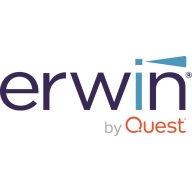

Camunda and erwin Data Modeler compete in enterprise process automation and data modeling, respectively. Camunda holds the upper hand in process automation features, while erwin specializes in advanced data modeling and visualization capabilities.
Features: Camunda is recognized for its lightweight architecture supporting BPMN, CMMN, and DMN standards, an open-source model allowing for flexible customization, and seamless integration with REST APIs. erwin Data Modeler offers superior data visualization, strong reverse engineering and synchronization features, and comprehensive data management support.
Room for Improvement: Camunda users call for better navigation between diagrams, improved UI, and enhanced integration with more technology stacks and cloud databases. erwin Data Modeler requires more efficient reporting, better integration with cloud systems, and updates to its pricing structure for different regions.
Ease of Deployment and Customer Service: Camunda provides flexible deployment across private, hybrid, and public clouds with celebrated community support, though there are concerns about standardized support costs. erwin Data Modeler offers strong on-premises deployment and streamlined customer service, but users sometimes face licensing complexities.
Pricing and ROI: Camunda is cost-effective in its open-source form, though enterprise licenses can be pricey. It offers good ROI through enhanced process efficiency and reduced development time. erwin Data Modeler, while more expensive, justifies its cost with extensive features and concurrent licensing, providing value in complex data modeling tasks.
It replaces manual charting in Visio with a structured tool, providing significant return on investment.
AWS provides the best support, followed by Microsoft, and then Google.
They provide better support for the enterprise edition.
Quest is committed to keeping the product robust.
Camunda offers a high level of scalability, especially when using its SaaS model, which manages and scales implementations automatically.
It allows for easy scaling, especially with ECS service configurations.
I would rate it probably a nine, making it a leader in data modeling.
There haven't been any significant outages in my experience with Camunda.
New versions often introduce enhanced features but may cause model crashes due to memory exhaustion.
More open documentation would be beneficial to understand the deployment process better and facilitate easier setup.
There is an issue where, in some situations, I need to scale up by observing both CPU and memory usage of containers, yet under the current options available at Amazon, this is not possible.
AWS pricing is very competitive compared to Azure and cheap compared to Google.
There is a licensing cost for using the SaaS model and Enterprise edition of Camunda.
ECS also allows for horizontal scalability with thresholds that can be configured for CPU or memory.
The biggest difference between Camunda and Bonita might be that Camunda is simpler and more flexible for setting.
Transitioning from a logical to a physical environment with just a switch is key.


Camunda drives business process automation and AI orchestration, enhancing efficiency and innovation without compromising security and governance. Trusted by major brands like Atlassian, it seamlessly integrates systems and human tasks for impactful digital transformation.
Camunda is renowned for fostering collaboration between business and IT, empowering over 700 organizations across diverse sectors to manage and improve business-critical processes. With its flexible architecture, Camunda supports BPMN, CMMN, and DMN standards, allowing for efficient modeling and smooth integration with environments via REST APIs. This open-source platform offers extensive customization and combines enterprise features such as process history tracking and decision table editing, supporting both technical and non-technical users in achieving efficient automation strategies. While performance and scalability issues exist, especially in the cloud, Camunda remains a top choice for companies like ING and Vodafone.
What are Camunda's standout features?In sectors like banking and government, Camunda's fast prototyping and workflow automation capabilities optimize processes such as client onboarding and investment banking workflows. It enhances social governance tasks, credit flows, and enterprise integration, while also being used in insurance and telecom for automating repetitive tasks and improving efficiency. Organizations utilize Camunda for training and service management, showcasing its versatility across industries.
erwin pioneered data modeling, and erwin Data Modeler (erwin DM) remains trusted, award-winning software for data modeling and database design, automating complex and time-consuming tasks. Use it to discover and document any data from anywhere for consistency, clarity and artifact reuse across large-scale data integration, master data management, metadata management, Big Data, business intelligence and analytics initiatives – all while supporting data governance and intelligence efforts.
We monitor all Business Process Design reviews to prevent fraudulent reviews and keep review quality high. We do not post reviews by company employees or direct competitors. We validate each review for authenticity via cross-reference with LinkedIn, and personal follow-up with the reviewer when necessary.